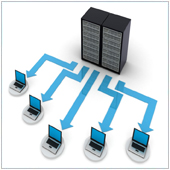
This month's article highlights another under-appreciated, but very useful technology that's built into Microsoft's Windows Server products. (In case you missed it, here's last month's post on Active Directory.) Remote Desktop Gateway is a service that enables people to securely log into their company's Windows computers from any Internet-connected device that's running a Remote Desktop client app. That can be a Windows PC, a Mac, a tablet, or even a smartphone. Yes, you could log into your desktop PC from your iPhone and run Quickbooks, though I'm not sure I'd recommend it for very long.
Many people are familiar with remote control solutions like LogMeIn, GoToMyPC, pcAnywhere, and so on. Microsoft has had its Remote Desktop (originally called Terminal Services) software for years, but using Microsoft's solution to connect from outside the office meant using a VPN, or opening holes in the firewall, both of which carried potential risks, and added complexity. When Remote Desktop Gateway was introduced with Windows Server 2008, it promised to simplify and secure the process.
Here are 5 reasons to consider Remote Desktop Gateway if your company is looking for remote-access solutions for your employees.
- Connections are Secure. By using SSL Certificates (the same technology that secures your communication to online banking and ecommerce sites), and requiring only a single firewall opening, the remote connection is kept safe from eavesdropping and hacking attempts.
- No VPN Required. Any device with an RD client can connect directly over the Internet without opening any unnecessary tunnels between your corporate network and an employee's home computer. This can save money on VPN solutions, keep things simpler for users, and limit your exposure to possible malware introduced by a non-secured home computer.
- One Connection, Many Options. You may have a Remote Desktop Server that many people can log into concurrently, or you may allow employees to connect remotely to their PCs at their desks. In either case, the same connection to the Remote Desktop Gateway acts as a bridge to the company computer that the employee is connecting to. There's no need to worry about IP addresses, or DNS servers, or any of a number of other requirements that would be true of a VPN solution without RD Gateway. All that needs to be entered into the client connection is the name of the PC to connect to.
- Remote Desktop Gateway is Part of Windows Server. If you have Windows Server, you have Remote Desktop Gateway, and may need only to add an SSL certificate to get things configured.
- No Third-Party Sites. With many remote-access solutions, both the remote controlling device and the remotely controlled computer have to make a connection to a server operated by the remote-control service in order to make the connection. With RD Gateway, the connection is made directly to your company network with no intermediary required.
When it was first introduced, many of the RD Clients for non-Windows platforms didn't have support for Remote Desktop Gateway. However, that's no longer the case, as Microsoft has released clients for Mac, iOS, and Android in addition to Windows and Windows Phone, all of which support RD Gateway.
If you'd like to learn more about using this feature in your company's remote access solution, just ask us!

Leave a comment!
You must be logged in to post a comment.